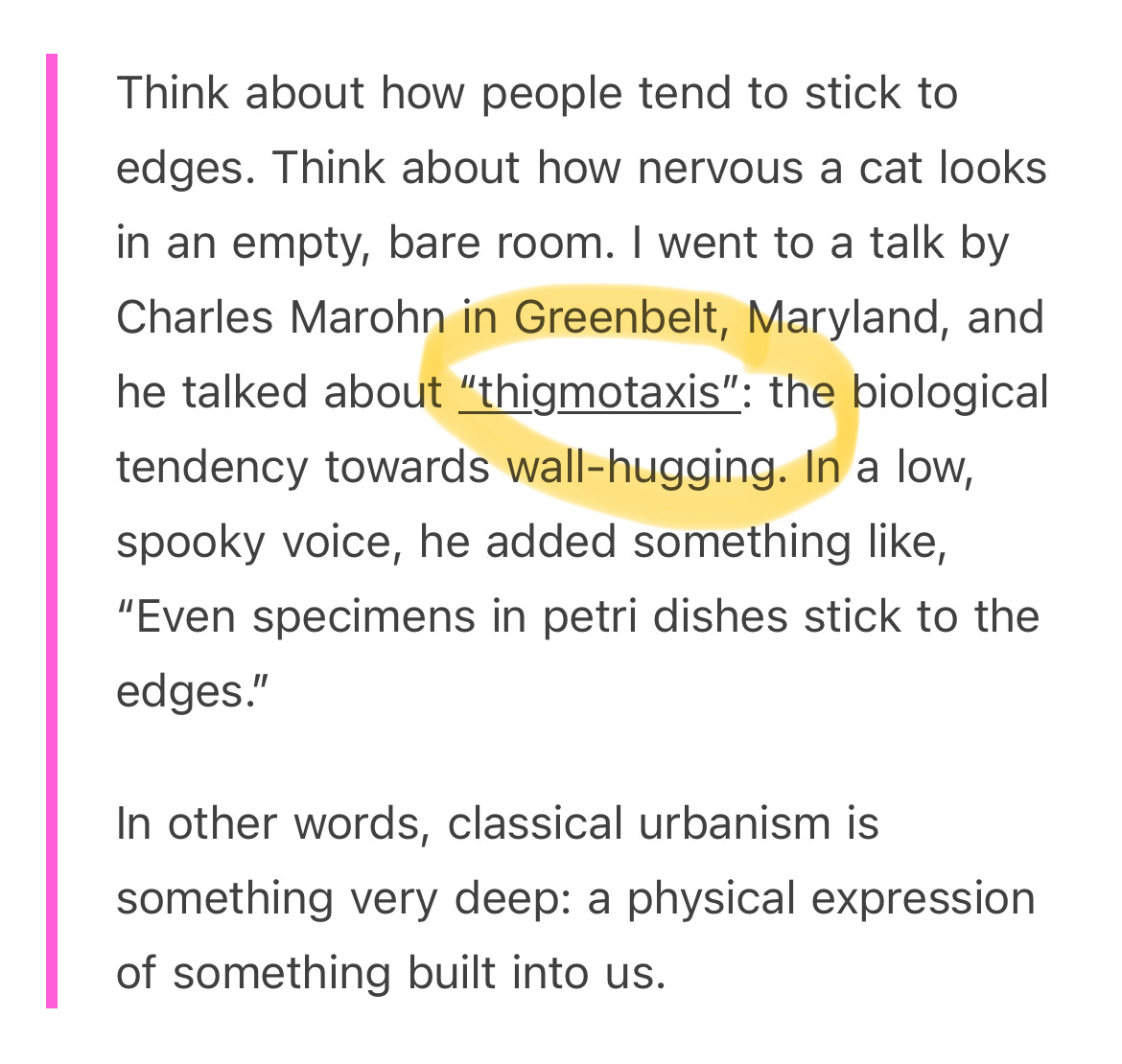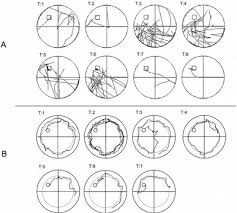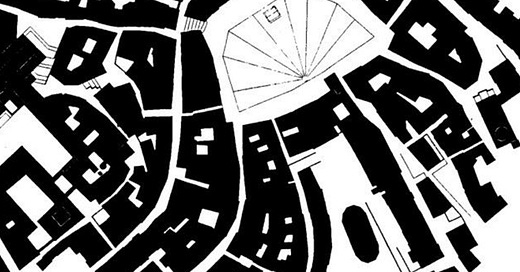The Readers Have Spoken!
Well everyone, you’ve spoken and I have looked at the results. I was hoping that ‘ventripotent’ would be the next word chosen for me, as it’s obliquely connected to the holidays. Kinda. If you think about it. But I am nothing if not honest, and you voted ‘thigmotaxis,’ so ‘thigmotaxis’ it is! (‘ventripotent’ was second place in the voting though, so stay tuned for that one next week.)
Thigmotaxis
The definition (according to sciencedirect.com) of this fun vote-winning term:
“refers to a specific behavior of animals (i.e., to stay close to walls when exploring an open space).”
You’ll see it also defined as an animal’s (or insect’s) response to touch stimulus. You know, like when there’s a spider in your house and you’ve got the cup and card ready to capture it, and you nudge it with the card and it runs away from it (or runs onto it)? That’s a response to fear (or anxiety), and it’s also thigmotaxis. Mice when dropped in a maze will stick to the walls until they get used to their new environment. And if you’ve had a pet and have had to move, you’ll have seen them hug the new walls of your bare space before they acclimate and the new rooms get furnished. Thigmotaxis has even been used in studies and treatments of human anxiety issues like agoraphobia. Turns out that humans too, like to stick close to walls when encountering an open space.
But weirdly, the biological studies world is not where I first encountered this word and was interested enough in it to add it to my list of word prompts for this series. I first encountered it in one of prolific urbanist Substacker Addison del Mastro’s pieces about cars, suburbia, and cities, wherein he discussed how kids are drawn to cities, how they love construction equipment and the process of city building.

Backs to the Walls
Finding the edges is my immediate habit as an ambivert when entering a party or a large crowd: the old term is ‘wallflower.’ That’s what it means, after all—hugging the walls out of social anxiety, observing the room from the safe distance of an edge. So I wonder why I like to be onstage and to take center stage? What does it say about those of us who are comfortable in the spotlight—how does that comfort relate to an instinctual thigmotaxis? How come I thigmotax myself when in a crowd, but love being in front of them, on display? Hm… now that I think about it, being onstage is kind of a way of being against the wall, huh? Even though it’s true that when lit, I can’t exactly see the crowd, I’m still off to the edge, behind the border of the stage apron, my back not to the crowd but to the back wall, set, or sparkly curtain, in the case of Blue Dime Cabaret shows. Is being onstage an extreme form of thigmotaxis, or is it the opposite?
This term (or at least, a variation thereof) was new to Pat Cornelison in 2015, too, writing for Boston-based architecture and design firm, Arrowstreet. This musing about thigmotaxis was exactly what made me curious about this word, too:
I learned a new word, thigmotactic. A strict definition is something like contact-loving, but in the context of placemaking it is generally used to mean edge-seeking. When selecting a place to stop and rest, people, and apparently most animals, head for the edges of an open space. This is a behavior long cultivated by evolution. If you sit with your back to a wall, no one can sneak up behind you. And an open space in front of you gives you a good command of the general goings-on.
But back to urbanism, cities, and thigmotaxis: In ‘Born This Urbanist Way,’ del Mastro cites (and widely quotes) an urbanist called Charles Marohn, who in his work as founder of Strong Towns advocacy group, discusses ‘the spooky wisdom of cities’:
Marohn … describes cities as “human habitat”—as natural as an anthill—and argues that we have coevolved with our traditional built environments. Many of the design features of traditional urbanism are, in his telling, the human implementation of something deep within us, below the level of consciousness.
It’s funny—my parents made a point of moving to Boulder from Chicago when I was 2 years old, specifically to get me out of what seemed (especially to my Dad) to be a stunting and gray childhood in the dregs of urban life. Boulder had changed both my parents’ lives, profoundly—they came out West to visit their good friends from college, who had gotten married there, and they never looked back. Well I mean, they went back to Chicago and then they went back to Boulder. And then never looked back. But my point in bringing this up is that I’ve always loved and, more importantly, felt most comfortable, in Boulder’s more cosmopolitan areas. And, as much as I appreciate the gorgeous mountains my parents hiked me up it seems like each weekend growing up, I fell in love with NYC when I visited there for the first time; and as a teen and college student, much preferred the walkable shopping area, urbanlike Hill area near campus, and the café culture of those places in Boulder, small city though it is. And now that I live in Denver, I’m much more content, and though my occasional jaunts up into the mountains are always pleasant, I like them to stay occasional.
But there is something there about del Mastro’s advocacy for less car-centered suburban environments, which trap humans into too-isolated places, eradicate the healthy 3rd place, and so much more. I never got my driver’s license growing up in Boulder, nor working at the urban commuter campus of Auraria in downtown Denver—I was a real urbanite, doing a lot of walking and light-rail-taking. But the South of Denver city I live in now is much more sprawling, much more suburban in structure than urban, and so now I drive. Because you’ve got to, to get around out here at all. I must reiterate my gratitude for I.C. Brewhouse, a true 3rd place that’s just across the street. It’s the type of public place that you don’t usually get in places like this.

I do always prefer sitting at the bar whenever I popinate—is this a version of sticking to the edges, or is it more in line with my love of being onstage, which is its opposite? I’m trying to picture where I normally sit at various bars, and I can’t really tell which it is. What do you think?





Great post!
Did you know that plants also respond to edges? They don't move, but grow, in response to stimuli so it's called thigmomorphogenesis (developmental changes in response to touch). Roots grow AWAY from obstacles, while things like pea tendrils grow towards them, for support.
Knowing whether the walls are an obstacle or a support . . . that's the hard thing!
Really interesting! I get the desire to wall-hug when in a new place or anxious, but I wonder if oversensitivity to stimuli also determine whether we instinctively like cities or are drawn to the open outdoors. NYC overstimulates me quickly with noise, bright light, and too many people pressing close, regardless of whether I hug walls. It’s never been my go-to place. As a kid in the Bay Area, I liked going to San Francisco occasionally, but far preferred wandering the open, wall-less hills.